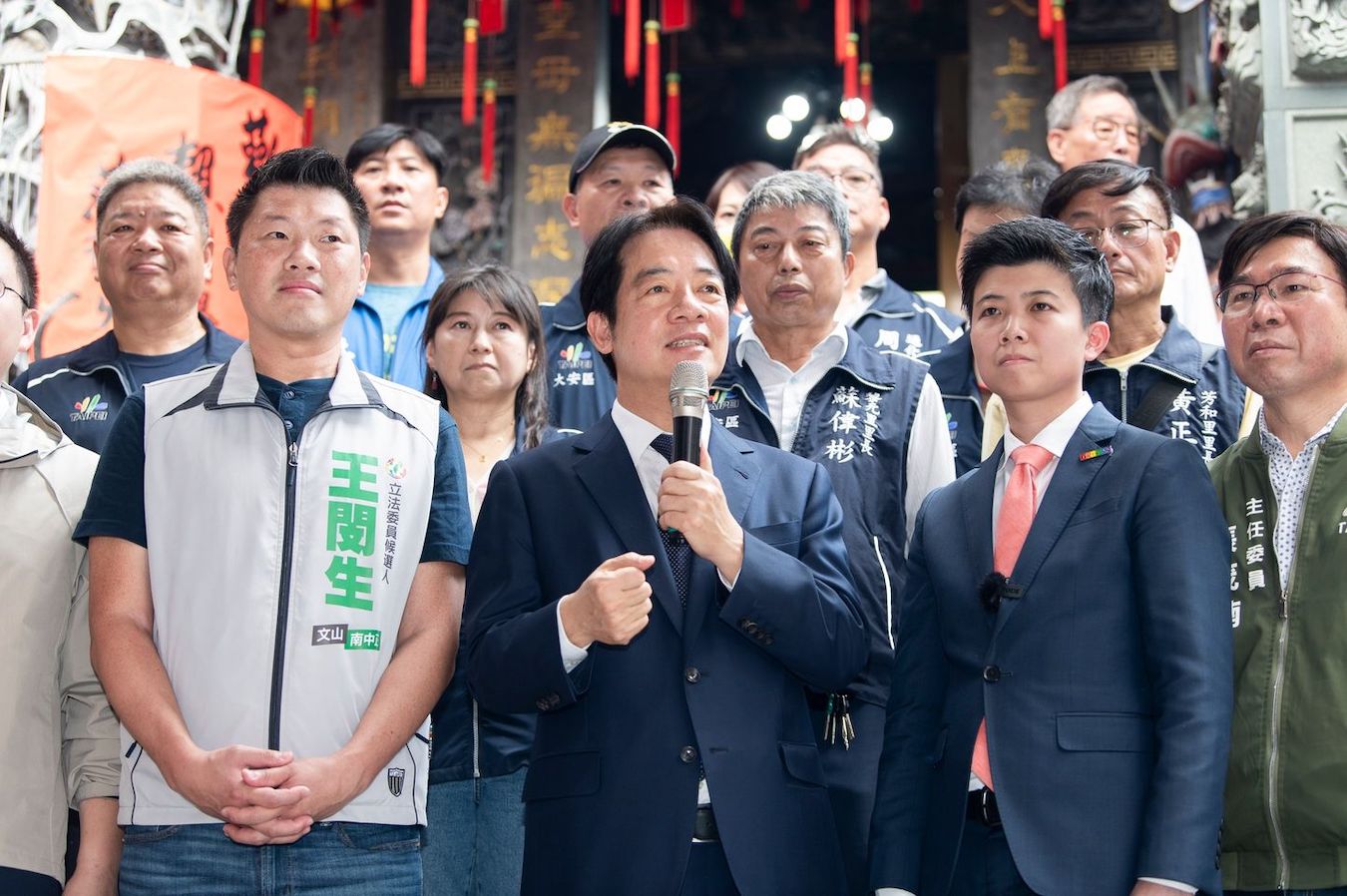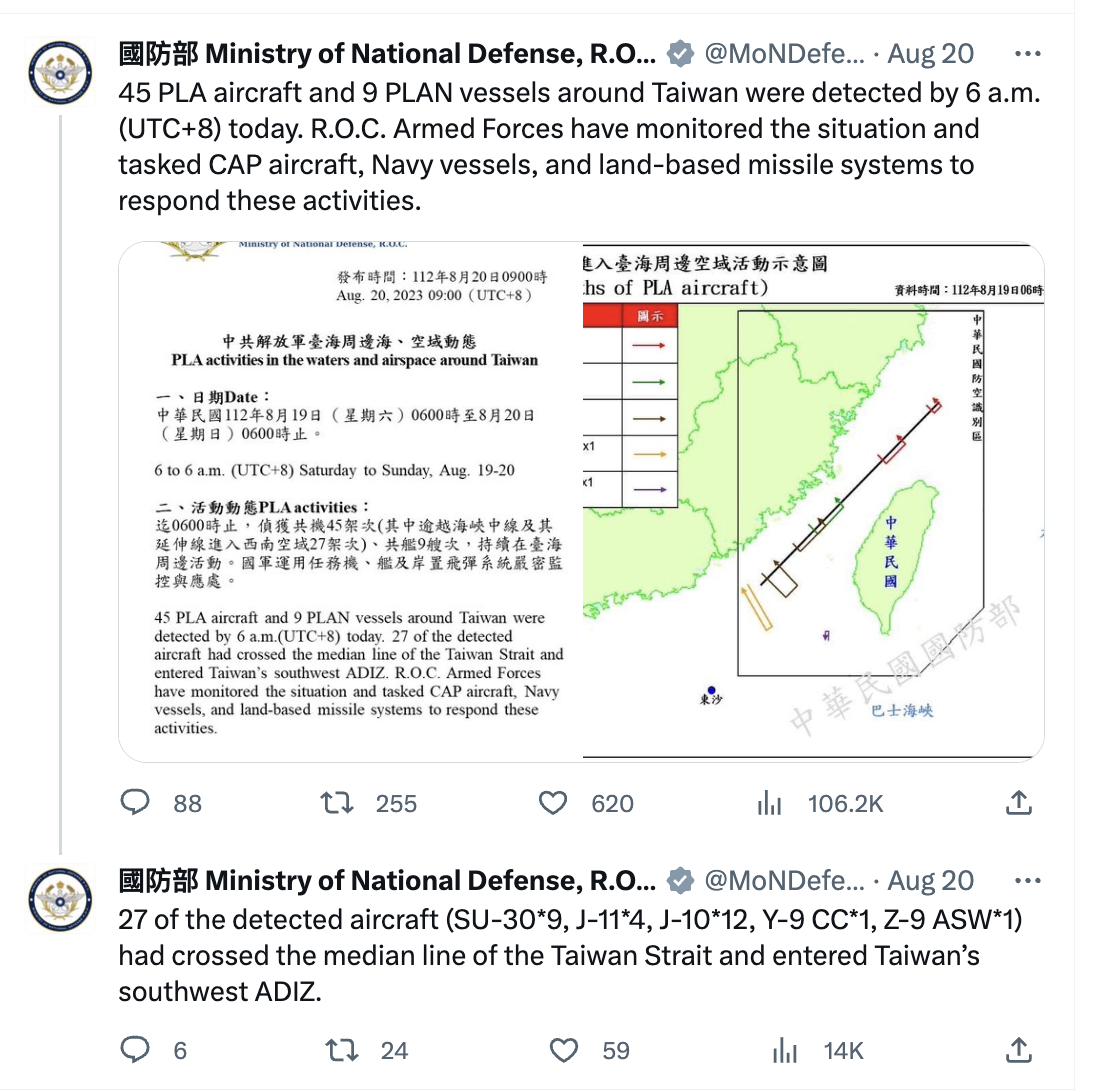by Brian Hioe
語言:
English
Photo Credit: Ministry of National Defense/Facebook
CHINA LAUNCHED another set of military drills after vice president William Lai returned from his trip to the US and Paraguay. Lai’s trip involved a stopover in San Francisco and New York City. Though the ostensible main purpose of the trip was to attend the presidential inauguration of Paraguayan president Santiago Peña, there was greater attention to the sensitivity of Lai’s transit through the US, given the possibility of a reaction from China.
In particular, with China announcing new drills, this primarily took the form of a one-day uptick in the number of Chinese military planes and naval vessels around Taiwan detected by Taiwan’s Ministry of National Defense on August 19th. 45 planes and nine vessels were detected, with 27 aircraft crossing the median line of the Taiwan Straits to enter Taiwan’s southwest Air Defense Identification Zone, the area where planes normally identify themselves for security purposes.
 DPP presidential candidate William Lai (center). Photo credit: William Lai/Facebook
DPP presidential candidate William Lai (center). Photo credit: William Lai/Facebook
This was a significant uptick from August 18th, when nine planes and six vessels were detected. This was back down to two aircraft and six naval vessels on August 21st. It is to be seen, then, if China again escalates military activity. Today, the Ministry of National Defense reported fifteen Chinese military aircraft and ten vessels.
China previously announced three days of military drills on August 12th, after Lai set off to the US. The military drills, however, were not as dramatic of an uptick from usual Chinese military activity around Taiwan, even if this may have involved more coordinated activity.
Drilling on either occasion was not on the scale of the Chinese military drills that followed then-US Speaker of the House Nancy Pelosi’s visit to Taiwan last August. The drills last August took place closer to Taiwan than during the Third Taiwan Straits Crisis.
China carried out drills in April around Taiwan as well, in response to the meeting between Taiwanese President Tsai Ing-wen and Pelosi’s successor as Speaker of the House, Kevin McCarthy. The meeting between Tsai and McCarthy took place in California, so as to reduce the pretext for China to carry out drills. The post-Tsai-McCarthy meeting drills were not as large as the post-Pelosi drills, but they were of greater scale than the more recent ones.
China marked its displeasure with Lai’s transit through the US by also announcing a number of trade measures against Taiwan. This included accusing Taiwan of violating international fair trade standards in banning a number of Chinese goods, then later announcing a ban on imports of Taiwanese mangoes. China has periodically sought to pressure Taiwan through bans of mostly agricultural products, ranging from grouper to fruit, such as pineapple, wax apple, and custard apple, as well as bans of recognizable Taiwanese snacks and beverages, such as Kinmen Kaoliang, Taiwan Beer, and Kuai Kuai.
It is possible that China decided to take a lower-key approach this time. After all, Chinese military drills could potentially provoke blowback from members of the Taiwanese public in a way that benefits the DPP in the presidential elections next year. This would be similar to the response from the Taiwanese public after a 2019 speech in which Chinese President Xi Jinping vowed that force was still on the table for reunifying Taiwan and China. Backlash against the speech is thought to have benefited Tsai’s re-election campaign, much as protests in Hong Kong against a bill that would have allowed Hongkongers to be extradited to China to face charges also gave further momentum to Tsai’s campaign at the time.
 Tweet by the Ministry of National Defense about the exercises
Tweet by the Ministry of National Defense about the exercises
In the aftermath of the drills last August, the KMT saw a victory in the 2022 local elections. Nevertheless, this was not thought to be the result of the public deciding that the KMT was the safer choice for Taiwan because of fear of Chinese threats. Rather, local elections are, as the name suggests, primarily about local issues.
This is not as likely to be the case with presidential elections, in which cross-strait issues play a more prominent role. As such, China may realize that it could potentially miscalculate through a military show of force that provokes backlash against it, and puts its proxies in Taiwan in the pan-Blue camp into a difficult position.
Nevertheless, China probably still felt that it had to have some means of registering displeasure, to avoid coming off weak. It is possible that tit-for-tat drilling will take place in the wake of the Lai transit and recent exercises, however, with a US carrier group stationed east of Taiwan during the same timeframe, and upcoming naval exercises by Quad nations earlier this month. Though the exercises were scheduled ahead of time, it is probable there was awareness of the possibility of China reacting to the transit during this time.

